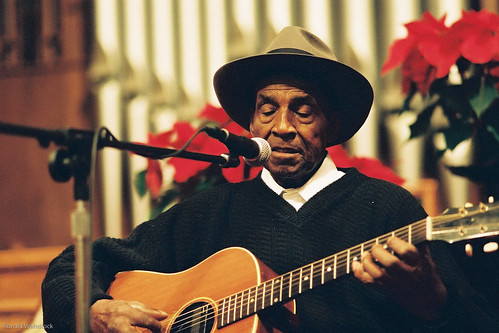
Its been decades since Long John Hunter was swinging from the rafters at the Lobby Bar in Juarez, Mexico, across the border from El Paso. While he made some tough singles for small labels in the southwest such as Yucca in New Mexico including “El Paso Rock,” which became a staple of rocker’s Bobby Fuller’s performances as well. In 1993 Spindletop issued his first full album, “
Ride With Me,” which led to him getting known outside of the Lone Star State and New Mexico. The label and Long John later was picked up by Alligator who issued two more excellent discs by Hunter, “
Border Town Legend” and
Swinging From the Rafters.” With Alligator he was united with long-time friend Phillip Walker and Lonnie Brooks for the “Lone Star Shootout,” recording. There was an album shared with his brother Tom “Blues Man” Hunter, “
One Foot in the Texas” (Doc Blues). Since then he moved to Phoenix, Arizona area and while having some ‘heart work,” and no longer can swing from the rafters, but still playing his music and Dennis Walker, best known as Robert Cray’s producer has produced his latest recording, “
Looking For A Party” (Blues Express).
For the recording, Walker put together a band of Jim Pugh, keyboards; Richard Cousins, bass; Alan Mirikitani, rhythm guitar; Lee Spath, drums and cowbell; and a horn section. The songs are all originals, although Long John only is credited with co-writing the title track. Grace Jones Hunter (his wife) is credited with co-writing a couple of songs. Walker and/or guitarist Mirikitani have contributed to all of the 11 tracks. There is a mix of material covering a range of moods and themes from the light title track to “
Beggar Man,” a straight blues given a slightly mysterious feel lent by Pugh’s keyboards with Hunter’s back porch delivery with his grainy voice quite appealing. In fact what is evident is just how good he still sings and plays. “Looking For My Baby” has a Crescent City groove with some cowbell for punctuation with a typically nice guitar solo for Hunter whose use of space and silence is a model for many who tend to overplay. “
I Know a Man,” is a heartfelt gospel number co-authored by his wife with a soulful flavor to the performance that benefits from the restrained accompaniment. The other song she helped write, “
You Are My Love,” is a sincerely sung blues ballad. “
Apple of My Eye,” is a nice rocking shuffle with a lyric of having been through hard times and bad luck but his woman is the apple of his eye, while another late night blues, “
Greener Pastures,” has among the better lyrics here.
Compared to some of Hunter’s earlier recordings, the most of the lyrics seem generic, and lack the quirkiness and distinctiveness of the best of Hunter’s earlier recordings such as “
Crazy Love,” or “
Dream of the Devil.” This is not to say that these are bad performances or terrible songs, because that couldn’t be further from the truth as they are robust. Still, this is a worthwhile disc that reminds us fortunately that Long John Hunter is still around and playing his distinctive music. May you be lucky enough to have him visit a club or festival near you.
For the FTC, I got the review copy of this from Blues Express but I had purchased this prior to that by download.











